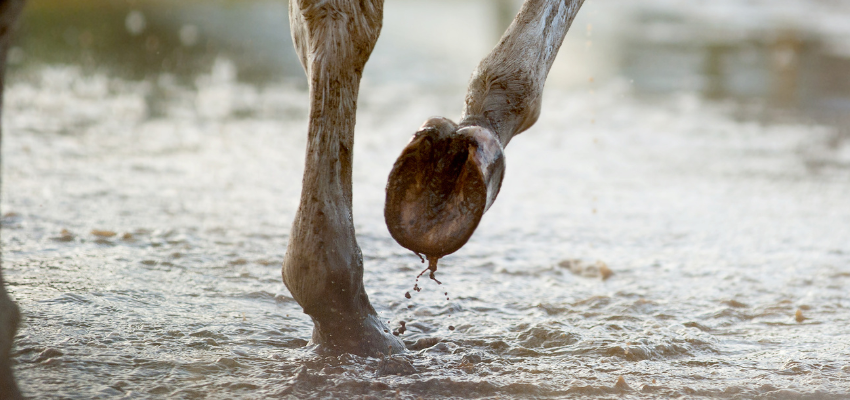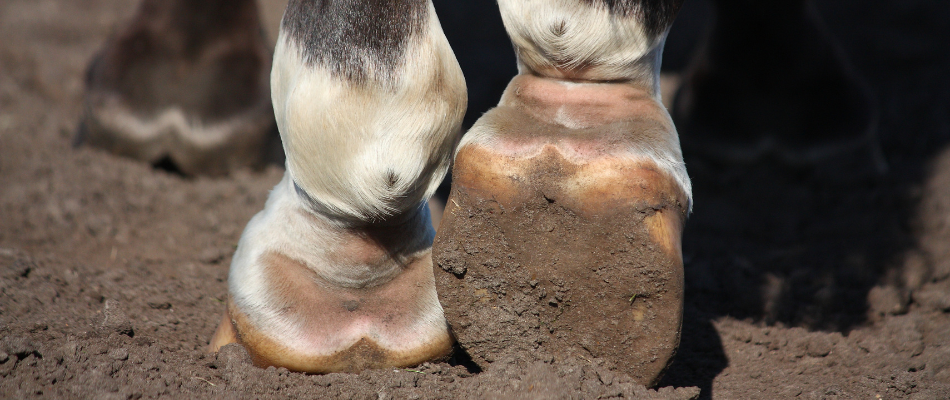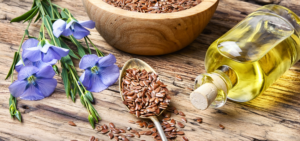Mud fever is a common skin disease in horses that can cause both unpleasant symptoms and serious consequences if not treated properly. It’s very important for you as a horse owner to know how mud fever occurs and what symptoms this disease is accompanied by. In this way, you can reduce the risk of mud fever disease in your horse or initiate appropriate treatment in a timely manner. In this article, you will find out exactly how you can recognize mud fever, what the causes of this disease are, and what treatment options are available.
What is mud fever in horses?
Mud fever is an eczema-like skin disease that occurs in the horse’s fetlocks. This is why it’s often referred to as fetlock eczema. It often begins in spring or autumn, during shedding.
Can every horse get mud fever?
Any horse breed can be affected by mud fever. However, some horse breeds with excess hair around their pasterns such as Draft breeds, Friesians, or Icelandic horses are more prone to skin diseases.

Symptoms of mud fever in horses
If your horse has any of the symptoms mentioned, this may indicate mud fever:
- Redness and swelling: If your horse’s skin in the fetlocks is red, swollen, and warm, this could indicate mud fever.
- Scabs and Cracks: Over time, scabby crusts can form on your horse’s skin. These can leave cracks and open wounds, which in turn can lead to infections.
- Purulent blisters: In some cases, purulent blisters may form.
- Hair loss: Hair loss can occur in the affected areas of the fetlock.
- Itching and restlessness: Mud fever can cause your horse to become extremely itchy and your horse will try to scratch or rub the affected areas. Over time, the itching can cause your horse to become restless.
- Lameness: If the mud fever is severe, your horse may begin to be lame due to the pain.
What types of progressions are there?
There are different forms of mud fever, which include:
- Dry skin disease: This is a mild form of mud fever because only the first layer of skin is affected.
- Weeping mud: Weeping mud is a more serious form in which deeper layers of the skin are affected. Purulent crusts and weeping rashes may occur.
- Warts mouth: Inadequate treatment of warts can lead to a chronic form. This leads to wart-like growths and swellings.
How does mud fever develop in horses?
There can be various causes for mud fever?
Skin damage
Skin damage is a common cause of mud fever. Once your horse’s skin is damaged it encourages the penetration of bacteria, viruses, and parasites. Such damage to the top layers of skin can be caused by:
- Obvious injuries from things such as prickly plants or thorns.
- Poor housing conditions: Poor hygiene, irritants such as ammonia in the soil or bedding, moisture, mud, and skin irritation caused by sand or cold, for example.
- Using unsuitable care products that attack your horse’s skin barrier.
Inadequate feeding according to needs
Another cause of mud fever in horses can be inadequate feeding, such as:
- Contaminated or spoiled food
- A diet that is too high in protein, sugar, or starch
- Changing food too quickly
- Allergies
- Malnutrition due to a mineral or vitamin deficiency
All of these points can lead to inflammation in your horse’s body, weakening his immune system, and promoting horse diseases such as mud fever.

Diseases
Illnesses such as metabolic problems, mites, fungi, immune system diseases, eczema, diabetes, or a limited ability to detoxify due to problems with the liver, kidneys, or intestines can also be a cause of mud fever.
Additional causes
Other triggers for mud fever in horses can be:
- Stress
- Vaccinations
- Deworming treatments
- Old age
On our website, Linda Tellington Jones shows you how to help your horse reduce stress and relax using the world-famous TTouches.
How can I treat mud fever?
Mud fever is often very stubborn. That’s why acting quickly and consistently is very important. These things can help you treat mud fever in your horse:
- Shortening the pastern covering: Try to keep the fur (or feathers) in the pastern area short. It is best to use scissors to shorten the hair to avoid additional skin irritation.
- Cleaning the pastern: You can wash and clean the affected areas of your horse with lukewarm water and mild skin care products, such as soap.
- Removing scabs: If scabs have already formed on your horse, you can soak them and try to remove them carefully. If the crusts cannot be removed, don’t just tear them off. This can cause additional damage to the skin.
- Care: After cleaning and removing the crusts, you can apply a thin layer of a mild, non-airtight cream to soothe irritated skin and promote regeneration.
When treating mud fever in horses, it is important to not just treat your horse itself, you should also make changes in the living conditions and hygiene:
- Clean and dry housing conditions: Make sure your horse is kept clean and dry to avoid further irritation of the skin and protect it from moisture.
- Feeding: Feeding often plays a big role in mud fever. Avoid high-protein feeding during the illness.
- Veterinarian: In order to really successfully combat mud fever, you should find out what is causing it. For this, it may make sense to contact your veterinarian. With the help of various examinations, he can determine what is causing the mud and recommend appropriate treatment measures.
Home remedies for mud fever
There are some home remedies that can help against mud fever:
- Propolis: Propolis is created as a byproduct of the production of honey. It has a strong antibacterial effect. You can apply propolis in the form of an ointment to the affected areas of your horse.
- Garlic oil: Garlic also has antibacterial and anti-inflammatory effects and can help fight mud.
- Sauerkraut wraps: Sauerkraut contains lactic acids and important minerals that promote wound healing and prevent bacteria from spreading.
What happens if I don’t treat my horse’s mud fever?
If mud fever is inadequately treated, chronic progressive lymphedema (CPL) can develop. This disease is manifested by tarnished and partially open legs, circulatory problems, and permanently swollen skin folds in the horse’s fetlock. If the CPL does not respond quickly enough, chronic edema can develop, resulting in increasingly thick scarring skin. This can ultimately lead to severe pain and lameness.
How can I prevent mud fever?

Housing conditions and your horse’s diet play a major role in mud fever, these measures can help you prevent it:
- Hygiene: Clean your horse’s stall, open stable, paddock, and pasture regularly. This ensures that the bedding remains clean and dry and the floor remains free of irritants.
- Dry Keeping Conditions: Make sure your horse is kept dry and mud-free.
- Regular checks: Check your horse’s pasterns regularly so that you can react quickly in the event of mud fever.
- Feeding according to needs: Feed your horse high-quality roughage. Adjust the amount of concentrated and mineral feed to your horse’s needs.
- Shortening the pastern hair: If you have a horse with a lot of pastern feathers or fur, it may make sense to shorten them a little. This allows the skin underneath to dry better, but at the same time, the water-repellent function of the fur is retained.
What is the difference between mud fever and rash?
Are you wondering what the difference is between mud fever and rash? Rash is also a skin disease in horses, which results in severe scaling on the back of the pastern joint. Over time, these scales form crusts and can lead to painful, open areas of skin. These crusty and open areas can spread throughout the horse’s cannon bone. The causes and treatment of rash and mud fever are often similar. The big difference is that rash is much more difficult to get rid of and it often ends up becoming chronic.
Mud fever in horses is a common and stubborn disease that can affect all horse breeds. If you know the different causes, symptoms, and measures for treatment and prevention, you can provide your horse with the best possible support.








